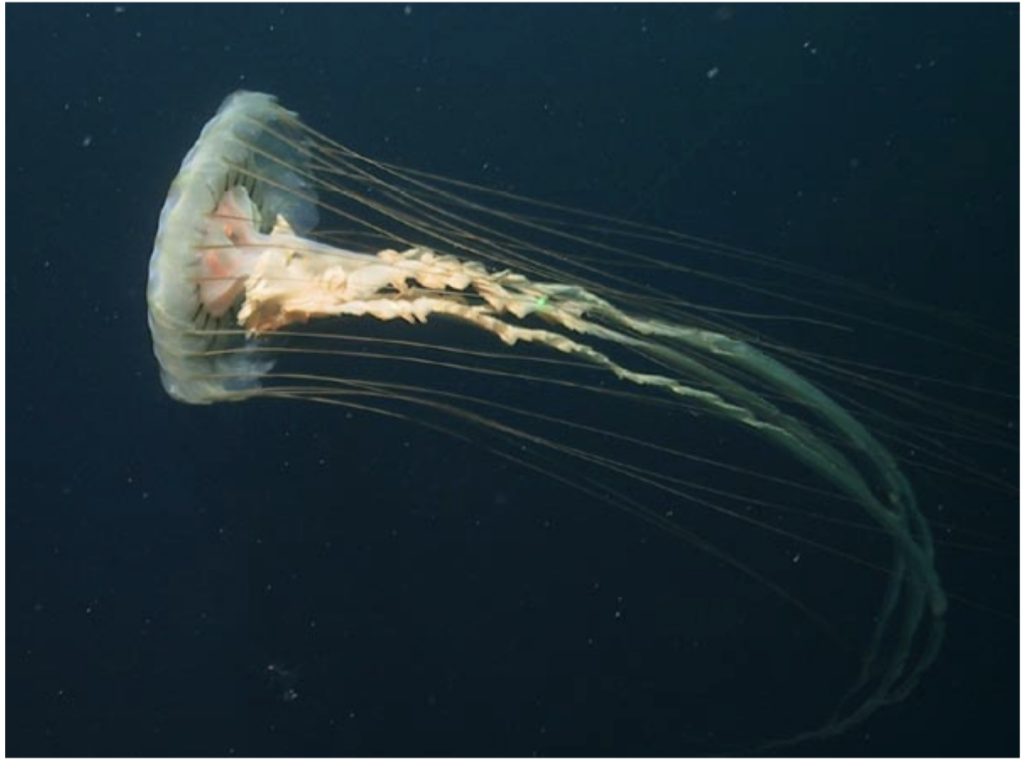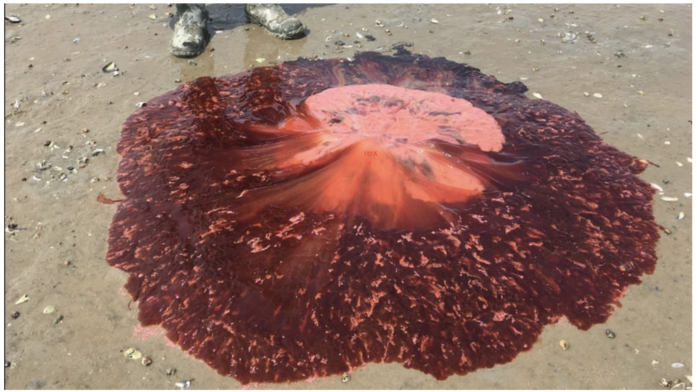Just when you thought it was safe to go back to the beach, another dangerous sea creature may be coming to an aquatic theater near you. This is not Covid-19. It is not the Red Tide in New York Harbor. We are not talking about shark attacks. But it does seem to be triggered by increases in ocean temperature as climate change is turning our seas into unpredictable spheres affecting the habitat of many marine species.
As the Maine lobster population migrates north into Canadian waters, an alarming five-foot long Lion’s Mane Jellyfish was discovered on a Maine beach earlier this month. Since 2015, these giants of the Arctic have occasionally appeared along the Maine coastline; however, their dimension has never been as large as the monsters we are seeing today.
CITIZEN SCIENTISTS ON THE LOOKOUT
A researcher connected to the Gulf Of Maine Research Institute, Dr. Nick Record, began to log the unusual sightings during that summer of 2015. He posted his request to recruit anyone who came upon the Lion manes to enter the data on his Bigelow Lab for Ocean Sciences weblog and send photographs for verification. Citizen scientists were responsive to his call.
Fast-forward to 2020, Dr. Record was interviewed earlier this week by the local Boston television station to shed light on the dozens of sightings in Maine and around Massachusetts Bay this month.
Admittedly, Dr. Record and his associates cannot offer a valid reason for the unusual jellyfish migration behavior. He states that there is no good historic data yet to develop predictive models. Once again, this year, his group needs to track the species everyone is seeing as he builds a library of jellyfish sightings. Even without data, New England beach-goers overwhelmingly say that climate change is real and it is here.
Craig Gilvarg, a spokesman for the Massachusetts Executive Office of Energy and Environmental Affairs has also weighed in on the world’s largest species of jellyfish, named Cyanea capillata. He corresponds on their Facebook page, “Their bell-shaped bodies alone can stretch as wide as 8 feet. If they live in plankton-rich waters their tentacles can grow to be as long as blue whales, which often span nearly 90 feet.”
Lion mane jellyfish are abundant and common to the North Atlantic and the Arctic Oceans. They are related to coral and anemones, not fish. Jellyfish are faring better than coral as the oceans become more acetic with climate change. Lion mane bodies are 98 percent water. Lion mane jellyfish use their tentacles to capture small fish although their main diet is zooplankton. This species is thought to be at least 500 million years old that dates them back to dinosaurs.

Lion Mane Jellyfish should not be confused with the Lion Fish. Lion Fish are not accustomed to cold water climates as they are most commonly found in Cuba and Florida. Lion Fish are also poisonous with barbs.
The National Oceanographic and Atmospheric Administration’s (NOAA) research vessel, Ocean Explorer, has recently conducted science data gathering of the Lion Mane Jellyfish. In 2019, the crew descended into the deep underwater environs of Northeast Canyons and Seamounts Marine National Monument. Seafloor mapping and exploration will continue this summer.

THE JELLYFISH IMAGE THAT BLEW UP SOCIAL MEDIA
Twitter handle UberFacts shared an image of a Lion mane approximately five times the size of a diver next to it on October 25th, 2015. Within the hour, there were more than two thousand retweets. The photo caption read, “In 1870, a Lion’s Mane Jellyfish washed up onto Massachusetts bay with tentacles measuring 120 feet (73 meters) making it larger than a blue whale.” Naturally, it caught the attention of the marine biology community. It wasn’t long before the Assistant Director of Science for the National Evolutionary Synthesis Center, Dr. Craig McClain, to write that he knew the picture had been doctored. He found the same photo without the diver next to it. Sensationalism won out as the Lion mane is now prominently in the public eye.
HOW DO JELLYFISH MOVE AND MIGRATE
Researchers are collecting data to determine if Jellyfish migration is purposeful or accidental. The marine scientific community does not offer a genetic or learned mechanism as a reason for jellyfish to move over the ocean like salmon or whales who return to the same location annually to spawn. Jellyfish commonly float in currents, but they do swim by contracting their bell-shaped body.
Jellyfish models have been the cornerstone of robotic propulsion. Only recently, a study at Woods Hole Oceanographic Institute discovered their propulsion to be extremely efficient as they experimented with jellyfish-inspired robots that could pulsate through the oceans to measure temperature and salinity with limited use of energy.
As of today’s post, only the New England coastline has reported sightings and encounters. With the Covid-19 pandemic wreaking havoc on professional sports, the betting industry might be interested on taking odds on the chances the Lion mane bloom will be coming to New York and New Jersey beaches?
TREATING THE STING OF A LION MANE JELLYFISH
New York and New Jersey ocean enthusiasts have lived with a variety of stinging jellyfish over the past four decades. Portuguese Man-o-War have visited our shores and thankfully, the Box Jellyfish has not made its appearance to date. “If a beach-goer encounters a lions mane jellyfish, they should move slowly up current and away from the animal to avoid tentacle exposure.” Craig Gilvarg offers. “If stung, flush the tentacles away from the affected area with clean seawater thoroughly and don’t rub the area until the tentacles are gone.” A sting is extremely painful, but not life-threatening. There are people who are allergic to the venom, so all should be vigilant.
REPORT YOUR SIGHTING OF A LION’S MANE JELLYFISH
We suggest beach-goers, fishermen, swimmers, boaters and all Citizen Scientists be vigilant and immediately report to your local administrations. If you like, you can report your discovery of the Lion Mane to Jellyfish.org sighting page. Sightings along the Gulf of Maine should be reported here to Dr. Record’s page. You can also contact us here at New York Harbor Channel.























Like!! Thank you for publishing this awesome article.
Actually, Lion Fish are also moving north. On a dive trip to the Outer Banks around 15 years ago, Holly and I saw a bunch of lion fish (and maybe 80 -100 Sand Tiger Sharks). As the ocean gets warmer, fish that would normally be limited to the Caribbean are migrating North.